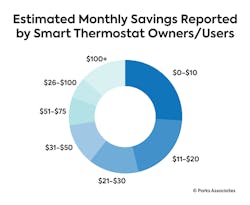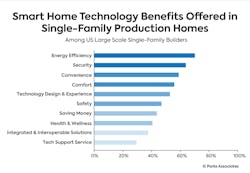This article originally appeared in the March 2023 issue of Security Business magazine. When sharing, don’t forget to mention Security Business magazine on LinkedIn and @SecBusinessMag on Twitter.
This is a dynamic time for the connected home industry, where multiple factors are aligning to drive interest in smart home devices and services. U.S. internet households now have nearly 16 connected devices on average, including 11 connected consumer electronics and three smart home devices on average; in fact, 41% of U.S. internet households (about 46 million), own at least one core smart home device, up from just 9% in 2015.
Key to the future progress of the smart home market is the ability for players across many industries to deliver a unified experience. Accomplishing that goal requires complex integration, extensive partnerships, and a focus on the consumer experience.
While security has remained a key driver for smart home adoption, energy management solutions are rapidly becoming more popular, as consumers growThese concerns can translate into new demands on both utilities, builders, and smart home manufacturers to adjust their products and strategies.
Smart Thermostat Adoption on the Rise
Residential security integrators are also working hard to provide consumers with devices to manage energy in the home, in addition to traditional safety and security services. Smart thermostats are a key device when it comes to enabling energy management services, and while adoption levels have been flat for the past few years at roughly 13% of U.S. internet households, new Parks Associates research reveals a 16% adoption rate.
The challenges to increasing adoption include cost, installation, and consumer awareness, as once consumers have the device, they report great satisfaction and savings overall. Parks Associates research shows 91% of smart thermostat owners report they are satisfied with the energy savings from their devices, and smart thermostat owners and users report saving on average $49 a month on electricity due to the device.
Innovations in energy devices and platforms enable utilities to supercharge this effort, allowing providers to deliver more detailed and useful real-time energy information and extend into control and conservation services that reach “the other side of the meter.”
Builders continue delivering more value, as more than half of large-scale builders in the U.S. include smart thermostats as a standard feature in homes, and 60% of builders report smart thermostats as highly popular features for their production homes. 82% of builders are interested in offering whole-home energy management as a smart home use case – which is an important step for all parties: utilities, builders, and end-users – to get the solutions in place that deliver the energy services and data needed for a unified and comprehensive experience.
Connected devices in the home can provide more information on energy consumption, including load profiles at start-up and runtime profiles during operation. The combination of these data sets enables consumers to understand how the operation of each device impacts their utility bill and could lead to more actionable guidelines to reduce their energy costs.
Getting this disaggregation data can be difficult, and many current utility programs offer data only in 15-minute intervals, while consumers today are accustomed to real-time data. These challenges are exacerbated by the nature of today’s smart home ecosystem, which consists of many disparate devices from different manufacturers.
Barriers to Adoption
The standard smart home buyer journey today is via retail, often one device at a time, creating an experience where consumers are using multiple apps to control their devices; therefore, control is not unified, and data is often not shared among devices, creating a disjointed consumer experience.
These conditions have inhibited growth of the smart home market into the mass market. Some level of unified control is available via smart home hubs, security providers, internet service providers (ISPs), high-end custom installments, and even the master smart home apps on common smartphone operating systems, but consumers want a more unified experience, with integrated automation and intelligence.
For many consumers, the ideal solution would a platform that can aggregate all the disparate devices and services into a single unified source. As consumers accumulate more devices, they gravitate toward a single source of control. An IoT platform can also accommodate the different preferences among consumers regarding the control experience. The vast majority (73%) of smart home device owners or purchase intenders consider interoperability important for the technology in their homes.
As the smart home industry continues to grow up, more and more devices in different ecosystems in the home will be connected through a platform enabling future services. Security players have a key role in delivering security services, and the additional connected devices in the home that can be integrated and managed by the security platform. As more awareness and familiarity grows around energy management offerings, security players are in a unique position to add value through energy management offerings.
About the Author

Jennifer Kent
Jennifer Kent is Senior Vice President and Principal Analyst for research firm Parks Associates. www.parksassociates.com


